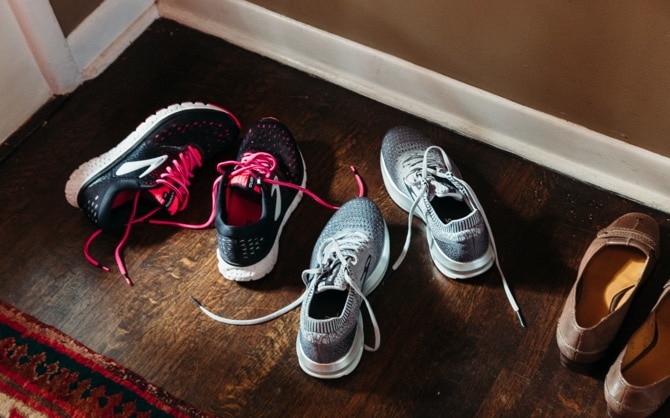When to replace your running shoes

So, you finally found a running shoe perfect for you. Together, you’ve been through miles of road, mud, rain, uphill, downhill, and everything in between. The highest highs. The lowest lows. The wettest wets. You’ve met your match and you’ll never part! Right? Well….
Look, we get it. Once you find The One and break in your go-to shoe, breaking up is the last thing on your mind. But trust us, it’s for the best. Even when running shoes don’t seem to be in bad shape, with a lot of wear, they simply can’t perform the way they used to.
With time, the outsole weakens and the cushion gets compressed. Whether or not you notice discomfort, worn-down shoes can’t protect your joints from impact. Which means an increased risk of injury. Which means um, no thanks.

How long do running shoes last?
OK, so they can’t last forever. When should you downgrade your old kicks to dog-walking status?
As a general rule, replace your running shoes after 300 to 500 miles (three to six months, depending on how much you run). But what if you’ve lost track — or you want to be extra cautious about overuse?
There are some external signs to look for: the bottom or sides are visibly beaten up, the treads are worn out, or the midsole is wrinkling. These are indications it’s time to give your shoes the boot, but don’t rely solely on what you can see.
What happens as running shoes wear out?
Focus on how your shoes feel and pay attention to changes over time. If your once-trusty pair leaves your legs or feet noticeably tired after each run (and you can’t chalk it up to a more intense training plan or another shift in your habits), it may be that the cushioning has lost shock absorption.
If your shoes start to fit differently than they did out of the box, that’s also a sign they’re ready for retirement. The materials have likely stretched or worn down. And don’t discount a vague sense that the ride feels different. That’s grounds for replacement, too.

Can you make your running shoes last longer?
Eventually, even the best shoes wear out, and you’ll have to call it quits. But you can prolong the magic by taking good care of them while you’re together.
First, use your running shoes only for running. Walking or standing for long periods, gym training, and other activities involving lateral motion create an unusual wear pattern — which breaks down the shoes faster. Performance running shoes are designed for one thing, and they’ll have the longest life if that’s all they do.
Also, while we don’t generally recommend dishonesty, we do suggest cheating on your favorite trainers. Keep two pairs in rotation, and alternate so you never do consecutive runs in the same shoes. You’ll allow time for each pair to completely dry and the cushion to reset between runs.
And on the note of drying: make sure you give your shoes some TLC after a rainy day. If you run in a downpour, through puddles, or in some other condition that soaks or submerges your shoes, take a few minutes to stuff them with newspaper and leave them in a warm place overnight. Avoid heat (dryer, heating vents, sunlight), as it can ruin the synthetic materials in the upper.
Try not to soak them, and just clean the surface. Stuff shoes with newspaper and allow to air dry. Voila. Squeaky clean (without the squeak).
Finally, shoes spend their lives real close to some real gross stuff. An occasional spa day will reinvigorate them. Keep it gentle and don’t use a washer or dryer — the shoes may get stretched or warped. Instead, take out the internal liners and hand wash your shoes with warm water and mild soap.
Try not to soak them, and just clean the surface. Stuff shoes with newspaper and allow to air dry. Voila. Squeaky clean (without the squeak). Learn more about cleaning your shoes here.
While taking good care of your gear should always be a priority, know that even the best-maintained shoes will someday wear out. By all means, treat them well. But treat yourself to a new pair when the old ones run out of juice.
